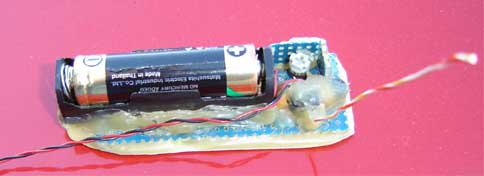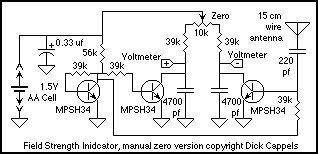Summary of Are you being spied – A Simple Field Strength Indicator (field strength meter)
This project describes a broadband field strength sensing probe with a 15 cm antenna, capable of detecting radio frequencies from 4 MHz to microwave oven frequencies around 900 MHz. The device outputs millivolt-level signals readable on a common multimeter and operates on a single-cell battery with low current consumption (60µA). Its design emphasizes thermal stability by thermally coupling three identical transistors and encasing the circuit in hot melt glue for protection. The probe is useful for testing various RF sources without using microcontrollers.
Parts used in the Broadband Field Strength Sensing Probe:
- 15 cm insulated wire antenna
- Three identical transistors (MPSH34 or 2N2222 as alternatives)
- 10k potentiometer (offset adjustment)
- Single cell battery
- Battery holder
- Punched fiberglass board
- Hot melt glue (for circuit protection and thermal stability)
This project is a broadband field strength sensing probe that has a 15cm antenna. It is able to detect radio energy and read the output on a common multimeter millivolts scale. It can be used to test 4MHz, 35 MHz, 55 MHz, 100 MHz, 384 MHz, 900 MHz, cell phone, and microwave oven. The meter is powered from a single cell battery and the circuit draws 60uA of current.

the temperature even among the three transistors (to minimize thermal drift), it protects
the components from physical damage, and it holds the battery holder on the board.
As I used this probe last nigh to determine if a 384 MHz oscillator was really working or not, I remembered email I received a while ago, asking how to make a field strength indicator without the microcontroller. Thus this page. If you want the auto zero version, which is this circuit with an auto-zero integrated circuit, use the circuit shown on this page for details.
This broad band probe has a small antenna (about a 15 cm length of insulated wire). Radio Frequency energy coupled to the antenna is detected and made available to drive millivolt level signals to the input of a DVM (Digital Volt Meter). Its battery powered for convenience with very low current drain and automatic shutdown for long battery life.

The MPSH34 has two things going for it: low input
capacitance, and I have a lot of them on hand.
I’ve used the circuit shown below to check the output of transmitters at 4 MHz, 35 MHz, 55 MHz, 100 MHz, 384 MHz, 900 MHz, a cell phone, and a microwave oven. It really is broad band, and I am sure the response varies considerable with frequency. Since the collectors and emitters of the detector transistor are both at RF ground, choice of transistors isn’t all that critical.
A low base-collector capacitance will enhance the VHF and UHF sensitivity. All transistors should be of the same type and thermallly coupled to one-another to minimize thermal drift. The DC gain of the detector is about 25X (estimated by multiplying the voltage drop across the collector load by 38). Assembly is not critical and mine was built on punched fiberglass board without a ground plane. The 10k pot is a the offset adjustment. For more info please visit Are you being spied – A Simple Field Strength Indicator (field strength meter)
